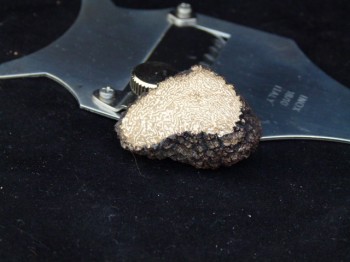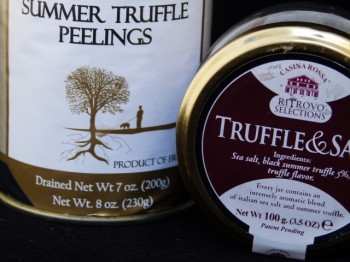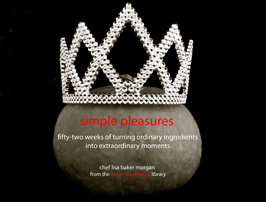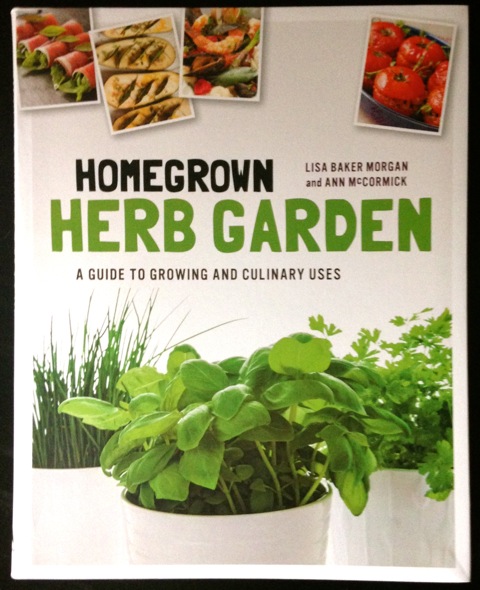what are truffles? and why do they cost so much money!
Truffles are a subterranean fungus (although their botanical names identify them as a tuber) that grow near tree roots (primarily Oak). Truffles are expensive primarily due to ever-increasing demand combined with an ever-increasingly low production. Combine that with their labor-intensive collection and their limited storage and you have a gastronomical rarity to be treasured.
The harvesting and sale of truffles is serious business. Pigs or dogs (today primarily the latter) root out the subterranean fungus, accompanied by a trufficulteur. The trufficulteur uncovers the each truffle (but not with his hands) and then replaces the dirt where he removed the truffle. Once harvested, the truffles are taken to the “truffle exchange” (my term), markets where the truffles are carefully weighed and money is exchanged with a courtier (a truffle broker).

truffle varieties,
where they come from, and when
The Black Truffle (Tuber melanosporum), the most well-known truffle and referred to as the “Black Diamond”, is from Périgord, France (although it can found in Provence as well as Italy). It is available from November to approximately March. Black Truffles are best in January and February after a good dose of cold, damp weather. Fresh Black Truffles smell sweet, earthy, and a little like chocolate.
The White Truffle (Tuber magnatum) or Alba Truffle is from Piedmont, Italy (although they also grow in parts of Croatia as well). White truffles are very rare and come on the market as early as October. The season for White Truffles is short, generally ending in December. They are milder than the Black Truffles and smell a little like garlic. They are more expensive than Black Truffles due to their short season and rarity.
The Burgundy Truffle (Tuber uncinatum) is a black truffle from Burgundy, France. It is available the same time as Black Truffles and White Truffles. They smell similar to White Truffles.
Summer Truffles (Tuber eastivum) have a crispy texture and are less fragrant than the White or Black Truffles. They have a nutty, woodsy smell. They are said to be best in July. Summer Truffles are found in France (the Burgundy region, Alsace and Savoy) as well as Spain and Italy.
Tuscan truffles are available in the Spring time. Out of all of the truffles, these are the least expensive and not the same caliber as the Black or White Truffles. They are often used in products such as oils, vinegars, pastes, and salts.
Truffles are also grown in the Pacific Northwest (Oregon) but are said to be less strong then those grown in Europe. Truffles are also grown in China, the Himalayans, and Croatia.
how to buy truffles
The quality of the truffle depends upon the weather conditions. It is best to buy truffles later in the season after they have taken advantage of the cold ground. However, if a truffle is over-ripe it will smell cheesy, smoky, musty, or even take on a gasoline smell.
The truffle should neither be mushy nor dehydrated looking. The veins on the inside should be bright and well-spaced (if they are too close together, the truffle is dehydrated). Summer Truffles have a black exterior with a dark beige, slightly pink interior. Black Truffles should have a dark charcoal/black, bumpy exterior with a charcoal interior with and white veins. White Truffles have a smooth, beige exterior and a lighter interior with pink veins. Burgundy Truffles look like Black Truffles on the outside but the interior is lighter and appears brownish (rather than charcoal) in color. Tuscan truffles have large white veins on their interior with a light brown exterior.
If you are buying fresh truffles, they should still have dirt on them. The dirt protects the aroma and preserves the truffle. Truffles are also sold in cans (either whole, grated, sliced or in pieces) or cryovaced (vacuum sealed in plastic), either fresh or frozen.
You can buy sea salt mixed with ground truffles which keeps its flavor for a long time. This is a great alternative to buying a whole truffle or truffle shavings and you can use the salt to enhance the flavor of a variety of things: eggs, soups, pasta, roasted nuts, butter, french fries, and popcorn, of course.
buyer beware
If you are buying fresh truffles, buy them from someone you trust. When you buy truffled products, carefully read the product labels because unfortunately, what most people recognize as “truffles” is a truffle aroma that has been created in a laboratory. Consumers pay high prices in markets and restaurants for truffled items, believing the the products contain truffles or were truffle-infused. Sadly, this is not the case. Products often appear to suggest or imply they have actual truffles or came into contact with a real truffle (and as long as they are not actually saying that to be true it probably passes legal scrutiny). For example, if the product says:
“truffle aroma”
“natural truffle aroma”
“natural black (or white or summer) truffle aroma”
“essence of truffle”
“natural essence of truffle”

most likely, that oil or butter has not seen, nor ever been introduced to, a truffle. What is “natural truffle aroma”? What is the “essence of truffle?” True a truffle is made up of aroma compounds which include sulphides (one of which is 2,4 dithiapentane which has a garlicky aroma). 2,4 dithiapentane can be created in a lab. In other words, you may be paying big dollars for a product that you believe is aromatic because it has been infused with truffles that were uprooted by pigs and collected by a truffleteur. In reality, your oil has been infused with the contents of a laboratory beaker which was mixed like a cocktail by someone in a lab coat. In sum, make sure that the ingredient list actually identifies truffles as an ingredient (not merely “truffle aroma” or something else equally as ambiguous and non-committal). A percentage should also be given to indicate the truffle quantity in relation to the other ingredients.
Tags: appearance, black diamond, burgundy truffles, how to buy, summer truffles, truffles, white truffles







Leave a Reply